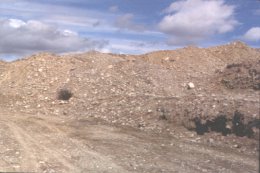If you were born in the month of September, sapphire is your birthstone. Sapphire is a variety of corundum or aluminum oxide and Al203 gives its chemical formula---that is, two parts of Aluminum to three parts of Oxygen. The axes are arranged in a hexagonal crystal, a crystal with four axes, three of which are of equal length and intersect at 60 degree angles, and one of which is unequal in length to the others and intersects the others at a right angle.
Sapphire's companion variety of corundum is ruby. Rubies are red to orange-red to purplish red. If corundum is pink, the United States Federal Trade Commission requires that the stone be sold as a sapphire. In the United States "pink rubies" are eliminated from the gem trade by legal definition. In the simplest terms, corundum that is any color other than red is a sapphire. Except for color, all of the other physical and optical properties of sapphire are identical to those of ruby and you are referred to the ruby page for these data.
Supply and demand has dictated that cornflower blue sapphires are the most expensive. These stones are rare and the finest examples come from Kashmir, a mountainous area in northern India on the Pakistan border. Geographic isolation, political instability and high demand all combines to make these stones very expensive.
Sapphires have been found in many other places in the world but few have attained the desirability of the Kashmir stones. In the United States, the Yogo Gulch area in Montana has historically produced some fine sapphires but few of these attain the size of the fine Kashmir gems. Labor and mining costs have been very high in the United States and the Yogo Gulch mines have generally not been profitable for the operators.
Fee localities are areas where one can pay a set fee for the privilege to extract gems and minerals from mines or claims that are owned by a second party. There are several such fee locality sapphire mines in Montana that have been profitable for both the mine owners and the prospectors who have chosen to pay the fee. The prospector pays a set fee for the right to extract a given weight or volume of sapphire bearing rock or gravel. The fee locality operators allow only the use of hand tools such as picks, shovels, crowbars, gads and wedges. The miner extracts the sapphire bearing rock with the larger tools. This material is sieved through a series of screens that allow the miner to separate and discard the extremely large cobbles as well as the very fine grained sand, silt and clay. The volume the miner pays for is actually only that that is in the size range that will produce the most useable stones. The sieved residue is placed in buckets and toward the end of the day the miners return to the base camp where the operators have electric shake tables that wash the gravel and concentrate the particles with high specific gravity toward the bottom of a pan. A half-ton of gravel may actually yield only a few pounds of sapphire bearing concentrate. When the concentrate is collected in the pan, the pan is removed from the shaker and is dumped over quickly on a flat table. The largest sapphires will normally be on the top of the pile or what was earlier the bottom of the pan. Smaller stones may be found through the rest of the concentrate.
In addition to sapphire being found in Montana, some stones have also been produced from mines in North Carolina where several fee localities exist. Alluvial gravel that covers much of the North American mid-continent has also produced an occasional sapphire for the lucky prospector. In the Old World sapphire has been found in alluvial gravel in Burma and Sri Lanka. Many of the colorless stones from Sri Lanka can be enhanced by heat treatment. There are many other localities of lesser importance throughout the world that have produced sapphires.
Johnson and Coeval (1998, p. 293, 294), citing F. L. Southland and M. I. Garland stated that corundum formed in two distinct geochemical environments. (1) Alkali basalt where partial melting of the lithosphere over rising plumes of the earth's mantle can lead to eruptions of gem bearing lava. (2) Sapphires from Montana formed in crustal metamorphic sources on the basis of low Gallium contents. Sapphire form in rocks that geologists call undersaturated, or rocks that have no free quartz. Spinel is another gem that forms in undersaturated rocks. Spinel may come in many of the same colors as sapphire and in earlier times many stones that were called sapphire or ruby included both corundum and spinel. Modern gem testing procedures can easily separate the two different minerals.
The colors of sapphires and rubies are controlled by trace elements that are included in the crystal lattice in amounts usually not exceeding about three percent. Some of these are listed in the table below:
- Chromium Oxide, Cr203---ruby
- Titanium Oxide, TiO2 and Ferrous Iron Oxide, Fe203----blue
- Ferrous Iron Oxide---yellow
- Chromium Oxide, Ferrous Iron Oxide---orange
- Ferric Iron Oxide, Fe304 and Titanium Oxide---green
- Chromium Oxide, Ferrous Iron Oxide, Titanium Oxide---purple.
For Further Reading
- Johnson, M. L., and Koivula, J. I., (editors) 1998. Colored Stones. In Gem News, Gems and Gemology, Winter, 1998, p. 293.
- Liddicoat, R. T., 1969. Handbook of Gem Identification. Gemological Institute of America, Los Angeles, CA, 430 p.
- Schumann, W., 1977. Gemstones of the World. Sterling Publishing Co., New York, 256 p.
- Shipley, R. M., 1971. Dictionary of Gems and Gemology. Gemological Institute of America, Los Angeles, CA, 230 p.
- Zeitner, J. C., 1996. Gem and Lapidary Materials for Cutters, Collectors, and Jewelers. Geoscience Press, Tucson, AZ, 347 p.









